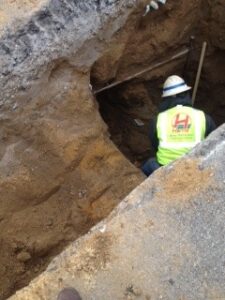A Queens homeowner called in a complaint to 311 after being made aware of a sinkhole that was forming in the roadway. The DEP field crew was called on the scene to begin investigative research. After a couple of hours investigating the surrounding neighbor’s houses, the DEP field crew narrowed the problem down to a potential sewer break at a neighboring house. The next step was performing a camera inspection on the neighbor’s sewer line which proved the DEP’s assumption to be accurate. The homeowner was issued a Cease and Desist order stating that they must correct the issue within a specific time frame.
 |
Upon day one of the Harris sewer crew’s excavation they realized that not only did the sewer have a large problem with tree roots invading the pipe, they also had a pre-existing pitch problem on the sewer pipe. A pitch problem AKA back-pitch may occur from the settlement of soil surrounding the pipe in a select area or the most common issue being a lack of pitch from the house to the city sewer when the pipe was initially installed. This will always cause an issue with a sewer pipe as a sewer works on gravity, all waste water must run downhill for the sewer to function properly.
In this particular case the homeowner’s pitch problem was stemming from the lack of pitch upon the initial installation of the sewer line. The Harris sewer crew could no longer perform a repair of the pipe as originally contracted, the entire sewer line now had to be replaced in order to obtain proper pitch. The first step was to raise the pipe inside the house which would allow for proper pitch once the new sewer line is installed from the house trap to the city sewer.
The on-site crew was able to successfully raise the inside piping, excavate the sidewalk and replace the old 4” clay pipe with new 6” extra heavy cast iron piping on day 1. The sidewalk excavation required to have an ISA certified consulting Arborist on site as the excavation process took place under the “drip line” of a city tree.
 |
On day 2 the on-site sewer crew started excavation in the street and replaced the old sewer line from the curb line where they left off the prior day, to the spur connection on the city sewer. The installation of the new 6” cast iron pipe required shoring as the excavation was deeper than 5’; the NYC DEP inspector successfully passed the new sewer installation confirming proper pitch on the pipe.
Harris Water Main & Sewer Contractors was able to respond to the DEP issued Cease & Desist Notice on an emergency basis avoiding a potentially dangerous situation for the surrounding neighbors. The entire job from the initial estimate, to the final restoration of the sidewalk and roadway was completed all within 3 days leaving another Queens resident extremely happy with their decision to hire Harris Water Main & Sewer Contractors.
History Of Floral Park, Queens
Courtesy of Wikipedia
 |
Floral Park is a neighborhood in the New York City borough of Queens. It is adjacent to the Village of Floral Park, which is in Nassau County. It may be distinguished from the latter by the use of the designation “North Floral Park”. The neighborhood is part of Queens Community Board 13.
Union Turnpike is the border between the neighborhoods, with Glen Oaks to the north. The other boundaries of Floral Park are roughly Little Neck Parkway (252nd Street) to the west, Langdale Street to the east, and a diagonal boundary from Hillside at 271 to Jericho Turnpike at 257 to the south. Floral Park is a middle-class neighborhood that consists mostly of Cape Cod-style houses. Most of the houses were built after World War II to accommodate returning soldiers. Veterans today make up 11 percent of all residents in Floral Park, versus 6 percent citywide.




















